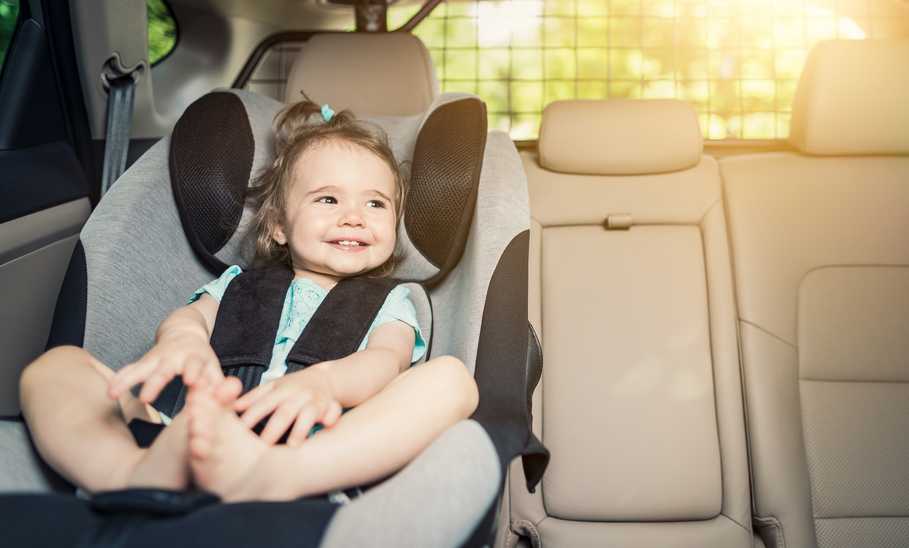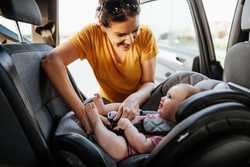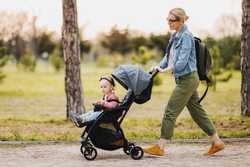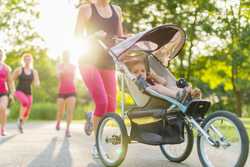When to Switch Your Car Seat To Keep Your Child Safe

Our evaluations and opinions are not influenced by our advertising relationships, but we may earn a commission from our partners’ links. This content is created by TIME Stamped, under TIME’s direction and produced in accordance with TIME’s editorial guidelines and overseen by TIME’s editorial staff. Learn more about it.
Car seats are imperative when it comes to keeping infants and children safe. In fact, when you have a baby or child in a car seat, the risk of injury in a crash is reduced by 71%-82% compared to seat belt use alone, according to data from the Centers for Disease Control and Prevention.
Just when you get comfortable with your baby's first car seat, it may be time to buy a new one. Like most, our family used three different ones for our kids at various ages and stages: an infant car seat, a convertible car seat, and finally, a booster seat.
Not all car seats are created equal, and the fit and size should be tailored to your kid's size and developmental stage in life—both of which change with some frequency. I spoke to child safety experts, nonprofits dedicated to car seat safety, and pediatric expert organizations. I researched the latest data on car seats and child safety and drew on my personal experience to create a guide to when to switch children’s car seats.
According to Joe Colella, JPMA director of Child Passenger Safety and 2020 Child Passenger Safety Hall of Fame Inductee, there are three extremely important things to consider before you buy a car seat.
When it comes to ensuring your child's safety on the road, independent crash testing should be your priority. While it's important to verify that the infant carrier meets the latest federal safety standards (Federal Motor Vehicle Safety Standard 213), simply meeting these standards isn't enough,” says Jeff Mills, director at Baby & Co.
He states, “What sets apart budget infant carriers from premium brands is the rigorous in-house testing they undergo as part of their design process. These manufacturers go above and beyond, designing seats not just for minimum requirements but to excel even at highway speeds. While this additional testing adds to the cost, it's a crucial investment that's clearly reflected in the prices of top-performing baby car seats.”
Colella adds, “Beyond convenience features for lifestyle needs, some car seat models offer safety enhancements that can improve their performance in a crash.”
Mills adds that there is a difference between a seat that merely passes a test and one that truly ensures safety. “That's why opting for a car seat from a brand specializing in car safety is paramount. Brands like Cybex, Maxi-Cosi, Nuna, and Britax have established themselves as leaders in car seat safety, not only in North America but also across Europe,” he says. “Trusting in their expertise and innovation can provide peace of mind for parents on the road.”
Mills shares the following three areas to look for in a car seat:
After safety, you should think about how your car seat will work within the framework of your life. This should be considered anytime you switch car seats (or to a toddler car seat) as the baby grows up. A few considerations from Colella include:
Related: The Best Car Seat Stroller Combos
When you have a newborn, the first seat you will likely own is a bucket-style, rear-facing car seat that snaps not only into a backseat but also into a stroller—usually referred to as a travel system.
Most of these seats snap in and out of a base that most families keep installed in their car(s) for ease. These seats have carry handles, so you can tote your baby easily in and out of a vehicle.
Infant car seats usually come with an optional newborn insert (that you most likely will need until they are around 11-15 pounds), which offers extra padding and support for their little heads and bodies if they are too small to fit safely in the car seat. Always check your infant seat’s instructions around its infant insert. Your infant’s shoulders need to reach the straps, so check with your seat’s manual about when to use the insert and also about when to safely stop using the insert.
Usually within a year, depending on the child, your baby will outgrow their infant seat, but according to the American Academy of Pediatrics (AAP), rear-facing car safety seats should be used as long as possible for all infants and toddlers until they reach the height and weight guideless as stated by the seat manufacturer.
A general guideline (and all models have their own set) for switching the infant seat to a convertible option is when your infant weighs up to 22-35 pounds and 26-35 inches, according to the AAP. When your child outgrows their infant seat, it may be time to switch the baby to a convertible option.

Mills advises that parents use the infant car seat for the maximum amount of time possible. Most infant seats can be used with babies up to 32 inches in length and a maximum weight (depending on the product) of 30-35 lbs, and most babies will hit that maximum limit by 15 months or so.
“At this point, you may want to look at a convertible car seat that allows your child to continue to rear face for as long as possible,” says Mills. “This [usually occurs when [the child] is 49 inches [long] or around 40 lbs.”
Keeping the baby rear-facing is crucial for safety when you move to a convertible seat, according to the global nonprofit Safe Kids Worldwide. Safe Kids Worldwide recommends that infants and toddlers remain in a rear-facing car seat as long as possible (and meet the manufacturer's requirements for height and weight).
The switch over to the convertible seat should happen then, and parents should review the manufacturer’s directions about how long their child can ride rear-facing, as many have limits that permit the length of time to sit rear-facing. As your baby grows, you could switch to a larger rear-facing convertible seat that will allow you to switch the child’s position from rear to front-facing when the time is ready. If you’re wondering when to turn the car seat around, look at the seat’s weight and height limit first.
When your child has outgrown the rear-facing weight or height limit, then it is time to turn them around. Always use a forward-facing car seat with a 5-point harness system, and keep your child in it as long as possible (until you reach the height or weight limit). In some countries, children stay rear-facing for many years. “Most car seat brands are now recommending rear-facing children until the highest weight or height of their car seat,” says Mills.
According to the National Highway Traffic Safety Administration’s website, there are three types of front-facing car seats.
A forward-facing car seat uses either a seat belt or lower anchor and clips to secure it.
Most convertible car seats have a lower and an upper attachment. When you turn your child forward, you’ll likely use the seat belt with the top tether to keep the seat secure (although always read the manufacturer’s directions).
While moving a child from a forward-facing car seat to a booster can be tempting, parents must understand the extreme safety issues associated with doing so too soon.
“We need to remember that children are not small adults; their bodies are structurally different,” says Mills. “Forward facing a child too early exposes them to more severe neck injuries, putting extreme forces on what is an undeveloped neck, spine, and head.”
Safe Kids Worldwide states on its website that a child in a forward-facing seat with a harness and top tether is more protected than one in a booster seat with a lap and shoulder belt or when using just a seat belt alone. The bottom line? The more protection, the better, and moving your child from a convertible car seat to a booster seat should wait until they are physically ready for one.
When your child has outgrown the weight and height limit for their car seat, it’s time for a booster seat. Car seats are tethered either up top or anchored in the seat. Lower anchors (the car seat clips into the seat) usually have weight limits. You can usually anchor a car seat up to a child being 65 lbs minus the weight of a car seat. So if your car seat is 6 pounds, the maximum weight of your child to be anchored (i.e. in a car seat that clips) would be 51 lbs. When you switch to a booster seat, most states require your child to weigh at least 40 lbs before you switch them to a booster.
“Booster seats take various forms, including those that have high backs, those that utilize the vehicle seat back for upper body support, and those that are part of a more comprehensive car seat (booster mode of combination harness booster seats or all-in-one car seats),” says Colella. “All of these types must be used with a vehicle lap and shoulder belt. Their shared objective is to elevate the child, guide the lap and shoulder belt onto strong, bony body structures, and ensure that the child can remain in a safe position for the duration of the ride,” he continues.
According to Colella, most booster seats can accommodate a child weighing up to 100 lbs and some even up to 120 lbs. “Because of design differences, it is crucial that families always follow the manufacturer’s instructions for height, weight, and age limits,” he says. “Since booster seats do not provide restraint directly, but instead position the child to take full advantage of the vehicle's seat belts and other safety features, these fit assessments are crucial.”
“A child should ride in an appropriate booster seat until the vehicle seat belt alone fits correctly.” adds Colella. Correct seat belt fit depends on the specific child and vehicle seating position, and proper seat belt fit typically occurs between ages 8 and 12.”
“It’s worth noting that booster seats reduce the risk of nonfatal injuries by 45% among four- to eight-year-old children when compared to the seat belt alone,” says Colella, an important stat supported by the National Institute of Health.
Other considerations for making the move from car seat to booster, according to the nonprofit Healthy Children website by the AAP, are as follows:
There are two types of boosters - high-backed and backless. Older kids usually use the latter, depending on their size. If you want to avoid having to purchase two types of booster seats, a convertible high-back that can be removed to make a backless booster may be more economical. According to the National Highway Traffic Safety Administration, children should remain in a booster seat up to the age of 12, depending on their size and age.
We kept our kids in high-back booster seats longer than they liked because of the extra level of protection they provided to children. Studies have shown that high back-booster seats reduce the risk of whiplash and other injuries for children.
High-back booster seats provide safety to the head and neck because they are built with side bolsters that provide shock-absorbing action in case of an accident. These use LATCH, and my kids' seats allowed the seat belt to go across their hips, shoulders, and chest. Different from the five-point harness of the convertible car seat, but provided more security than a backless booster. It is possible to find a convertible booster seat with a removable high back when a child outgrows the need for a high-back booster.
Older children who still need a booster seat may prefer a backless booster, which is essentially a cushion that keeps your child safe by allowing them to sit properly using a seatbelt. When you use a backless booster, make sure your child's ears are in alignment with the seat back of the vehicle. This is to better protect their neck and head in an accident, according to the Cincinnati Children's Hospital Medical Center, and a backless booster should only be used in cars with headrests for safety reasons.
Backless boosters are great for parents because they are lightweight and portable if you have to switch them in and out of multiple vehicles during carpools, field trips, or household cars. Most backless boosters are secured using the LATCH system, but some are not.
If your car seat is in good condition and has not been in a vehicular accident, you can donate, sell, or give it away as a hand-me-down. Warning: Make sure to check a car seat’s expiration date because parts can wear down over time. Manufacturers do provide an expiration date for every seat they produce. Usually, the expiration date is around six to 10 years after it was made.
A car seat must be used according to the manufacturer’s instructions to provide optimal protection, but for total peace of mind, you can hire a certified Child Passenger Safety Technician. These professionals are trained to help parents and other caregivers learn how to use car seats correctly; of course, you can install your own seat by carefully following the manufacturer’s instructions for the car seat and the vehicle.
“If a parent or caregiver faces challenges understanding or following the instructions, the first step is to contact the car seat manufacturer for specific advice (https://www.jpma.org/page/carseathelp) since the manufacturer is the ultimate authority for correct use. If hands-on assistance is still warranted or desired, working with a certified technician is a good choice,” says Colella.
Many families prefer to begin with an infant car seat because of convenience features like stay-in-car bases and matching strollers,” says Colella. “If a family starts with an infant car seat, they can use it as long as it hasn’t exceeded its expiration date and as long as the baby fits within the manufacturer’s weight and height limits. Once the child has outgrown the limits of the infant car seat, they should be moved to a larger car seat with higher height, weight, and age limits (convertible or all-in-one).”
The National Highway Safety Administration's online tool, the Child Car Seat Finder, is a great resource. This tool allows you to input your child’s age, weight, and height to help you find the right seat based on the data you provide. Plus, if you are new parents or guardians, consider working with a certified child passenger safety technician to ensure your car seat is ready to go.
The information presented here is created by TIME Stamped and overseen by TIME editorial staff. To learn more, see our About Us page.



